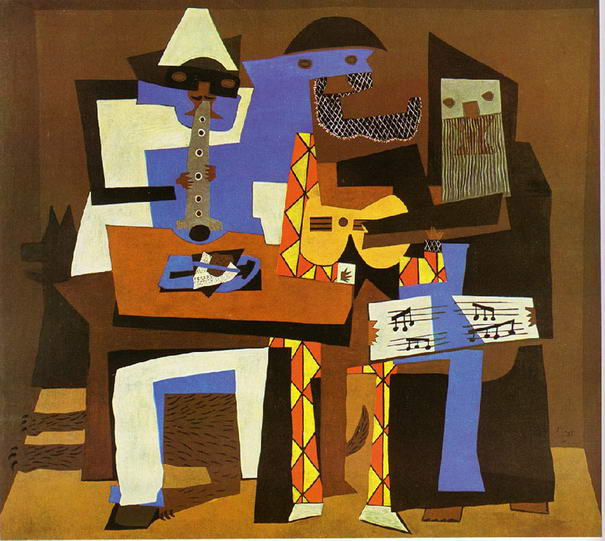Week 2: Mathematics + Art
Whether it is the time period of the childhood of Gillian
Lynne, whom Sir Ken Robinson refers to in his Ted Talks speech, or today, “every education system on Earth has
the same hierarchy” with the arts being at the bottom. For this reason, many children
and young students often find themselves lost in the mathematics- and science-driven
education systems. However, what they may not realize is that mathematics, as
Dr. Vesna makes clear, has an undoubtable influence on the arts.
 |
| Pablo Picasso's Three Musicians http://www.themost10.com/wp-content/uploads/2012/03/Three-Musicians-By-Pablo-Picasso.jpg?aa45da\ |
One of the clear examples of mathematics-influenced arts is
cubism, an early 20th century art movement pioneered by Pablo Picasso among
many others. The subjects in paintings created by cubism artists were
depicted not in the traditional single perspective, but a multitude
of perspectives. Cubism was something Linda Dalrymple Henderson would refer to
as the fourth dimension as it portrayed a departure “from visual reality and [rejection
of] the one-point perspective system that for centuries had portrayed the world
as three-dimensional.” By incorporating the idea of the existence of a fourth
dimension as well as primarily utilizing geometric shapes, cubism most definitely
relied on mathematics to achieve its magnificence.
 |
| An origami Tyrannosaurus Rex's skeletal structure http://www.tansu-style.com/robert-j-lang/robert-j-lang-web-gallery/images/12-P3120003_3.jpg |
Origami, the art of paper folding formed by the Japanese, can
also incorporate mathematics to achieve its beauty as Robert Lang suggests. In his
Ted Talks speech, Lang states that by following four governing laws of origami,
one can “give rise to that kind of complexity” such as constructing a skeletal
structure of a Tyrannosaurus Rex. Though origami is best known for the Japanese
paper model of a crane, with mathematics one’s creativity and translation of
that imagination to real-life figures are boundless.
While music has been existent for numerous centuries, the means of producing music has been constantly evolving. As recent at the 1900s, the primary means of music production was with the assistance of a live orchestra and a vocalist. Contemporary music may now have no need for a live orchestra or good vocalists as many instrumentals are solely produced with computer programs. These programs utilize various beats per minute, sound lengths, and frequencies, which are founded on mathematics, to replicate the sounds of instruments. It also allows for the possibility of auto-tuning out-of-tune vocal performances by correcting the singers’ frequencies of certain notes.
Works Cited
Henderson, Linda Dalrymple. "The Fourth Dimension and Non-Euclidean Geometry in Modern Art: Conclusion." Leonardo 17.3 (1984): 205-10. Web.
Repetto, Douglas. "Music and Computers." Music and Computers. N.p., n.d. Web. 09 Apr. 2016.
Repetto, Douglas. "Music and Computers." Music and Computers. N.p., n.d. Web. 09 Apr. 2016.
TEDtalksDirector. "Do Schools Kill Creativity? | Sir
Ken Robinson | TED Talks." YouTube. YouTube, 06 Jan. 2007. Web. 09 Apr.
2016.
TEDtalksDirector. "Robert Lang: The Math and Magic of
Origami." YouTube. YouTube, 31 July 2008. Web. 09 Apr. 2016.
Uconlineprogram. "Mathematics-pt1-ZeroPerspectiveGoldenMean.mov." YouTube. YouTube, 09 Apr. 2012. Web. 09 Apr. 2016.
Uconlineprogram. "Mathematics-pt1-ZeroPerspectiveGoldenMean.mov." YouTube. YouTube, 09 Apr. 2012. Web. 09 Apr. 2016.
Hi Albert
ReplyDeleteI like how you had many different examples for types of art that involves math. Like I never thought as music as a part of math until you brought up the point that contemporary music is mainly produced by computers. It is interesting how much math is intertwined with art.